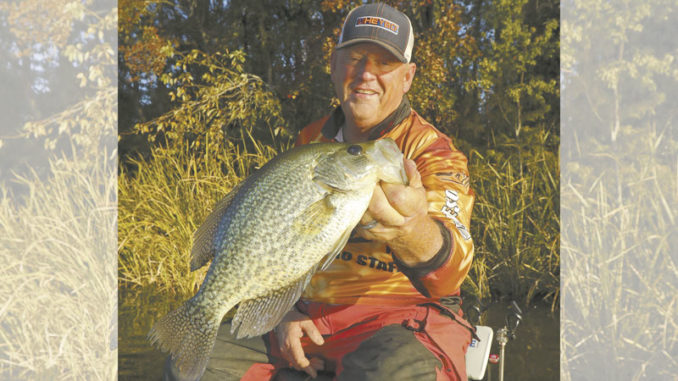
Don’t wait for March
In February, many fishermen in the Carolinas are chomping at the bit for March, when most freshwater fish become more active. But they need not wait. The cold-water crappie are biting just fine right now.
Whitey Outlaw, co-host of Father and Son Outdoors TV, grew up fishing South Carolina’s Santee Cooper lakes. But as a tournament crappie fisherman, he’s fished all over the country, in every month, and he loves catching crappie in February.
“You’re going to have the lake all to yourself on most days,” he said, “and the crappie are eating just fine this time of year. You can really find them in several different types of areas of any given lake. You’re going to find some deep on brush piles. You’ll find some in shallower water real tight to the base of flooded timber. And you can catch some under floating weed mats.
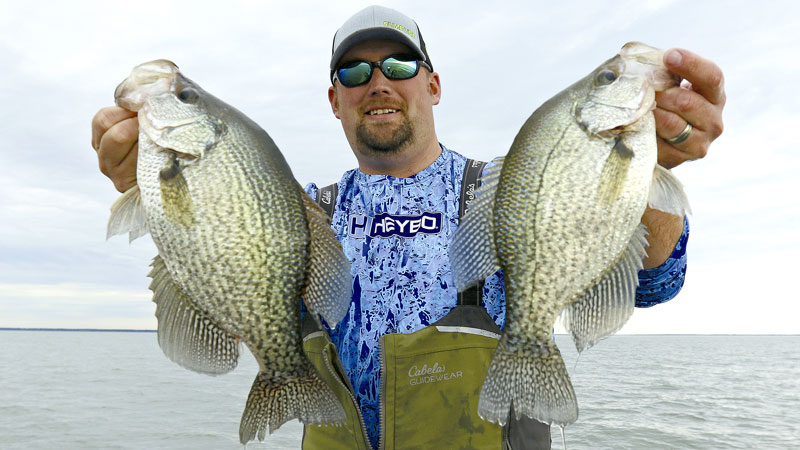
“Sometimes, one type of area will produce better than others. Other days, you can catch them in all three types of areas. The key right now is to use smaller jigs. Both the length and diameter of the jig should be a smaller profile than what you use in the spring. Tipping them with minnows is a good tactic, except when fishing those floating weeds.”
When it comes to catching cold-water crappie deep on brush in February, Outlaw said every lake is different.
“February can be a bit tricky when it comes to finding crappie on brush or other sunken debris in deep water,” he said. “If you’re in a lake with depths of 45 to 60 feet or more, you should find plenty of fish stacked up on that debris. They’ll be easy to spot on your electronics. You don’t want to cast to them. Just use long poles and lower your baits to them. You want to have your bait within a foot of the highest fish in the school. If you’re not getting bit, drop it down level with them.”
Sometimes, it’s best to move on
Outlaw said on some days, the crappie just won’t seem to bite, no matter what you do.
“If you still aren’t getting bit but you see the fish are there, it’s best to move on to another brush pile until you find a different group of fish,” he said. “But keep that first school in mind. You want to check on them later in the day. Sometimes, especially when it’s real cold, the fish just eat in really short spells. It can be frustrating to know they are there and not get a bite. But don’t waste too much time, because there are other fish that are willing to eat. You just have to find them.”
Outlaw said many anglers overlook a lot of crappie in shallow water at the base of standing timber like cypress trees.
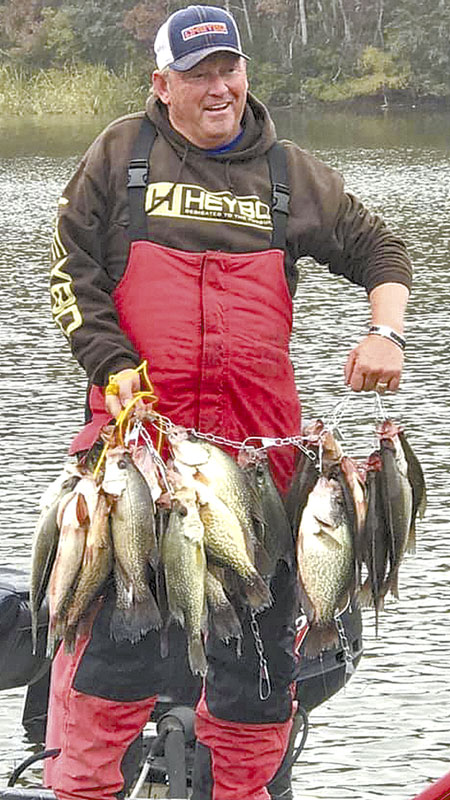
“Especially on a bright, sunny day, it doesn’t matter how cold it is. The sun is going to heat those trees up, and that will carry under the water,” he said. “The crappie will gather real tight to the base of those trees. Tip a jig with a minnow and put it as tight to the tree as you can. Work your way around the whole tree. It’s a game of inches. If you’re not putting it right in their face, you’ll miss a lot of fish.
“Unlike deep brush piles, these fish won’t be gathered in great numbers. You might pick up two or three at the base of one tree, then two or three at the base of another tree a few feet away. But if you’ve got flooded, standing timber in your lake, you can limit out this way. Just stay on the move, be a little more patient, and don’t be afraid to get your jig snagged. That’s all a part of fishing this way. If that’s not happening here and there, you’re not fishing close enough to the cover, especially if you’re not catching fish.”
Grass mats are good targets
One of Outlaw’s favorite February tricks is catching slabs under thick, floating grass mats. These structures hold crappie throughout the year, but Outlaw said they are especially productive in the summer and in the winter.
“This is when you don’t want a minnow on your jig,” he said. “Minnows will swim into the weeds, and you’ll get stuck every time. You want to fish this grass just like you do in the summer. Downsize your lures, and change colors often until you find what they’re biting. Fishing grass beds is a color game,” he said.
Outlaw prefers a 1/16-ounce jighead with a small Crappie Magnet jig. These jigs are short and small in diameter. He probes the holes between the floating vegetation in a vertical fashion. He also likes Charlie Brewer Sliders, which he said spiral down like a propeller when jigged vertically.
Outlaw said patience is important when fishing this way, but he stressed that anglers shouldn’t waste time if they aren’t getting bit.
“Especially in a lake that has a lot of these grass mats, you need to move on to the next one if you aren’t catching anything in a few minutes,” he said. “Patience in fishing is really about taking the time to get prepared, get the boat situated properly, and in getting your lures into the right spots. It’s not about sitting in one spot for 20 minutes without getting a bite.”
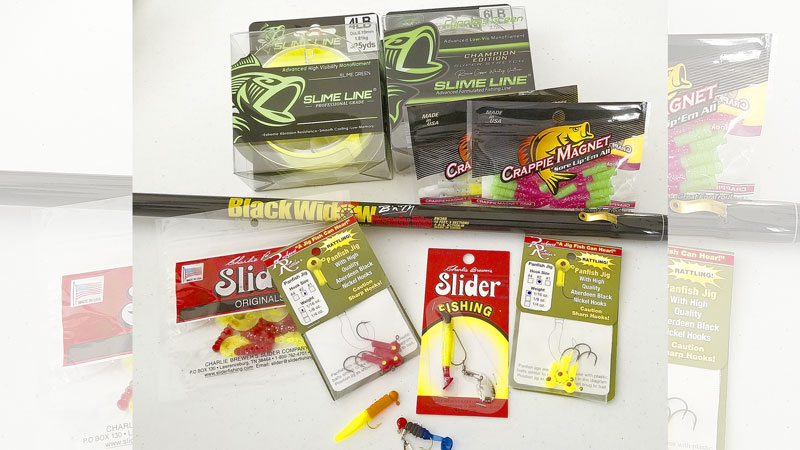
When braid doesn’t make the grade
Braided line is not welcome in a crappie angler’s boat. Bass fishermen love braid, one reason being its no-stretch properties needed for jaw-jarring hooksets. That’s exactly why crappie fishermen like Whitey Outlaw steer clear of braid.
“You’ll rip a crappie’s lips clean off with braided line,” said Outlaw, who has lost his share of crappie even when using regular monofilament.
“It’s a fact of life when crappie fishing,” he said. “Their lips are like paper, and even when you boat a fish with regular monofilament, it’s par for the course to see a hole in the fish’s mouth. If you asked every tournament crappie angler how many fish they’ve lost because they couldn’t quite get the fish to the net before their mouths tore and set them free, Lord have mercy, you couldn’t count them all.”
Outlaw teamed up with Slime Line, a manufacturer out of Roxboro, N.C., to develop the company’s Champion Super Stretch line, which stretches considerably more than other monofilament — up to 33% compared to 12% for most lines. That means less lip-ripping and more fish in the boat.
“Not only does the Slime Line Champion Super Stretch expand more, it also retreats back to its original length,” he said. “Other monofilaments don’t shrink back, and most begin to get brittle and weak once they’re stretched. This line is a game changer for crappie anglers in the same way today’s advanced electronics are for crappie anglers. That extra stretch gives you that little bit of extra time you need to get a net under that fish and get it in the boat.”


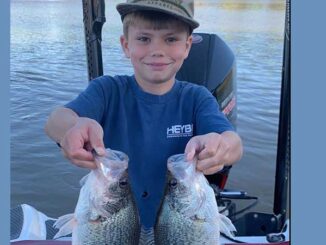


Be the first to comment